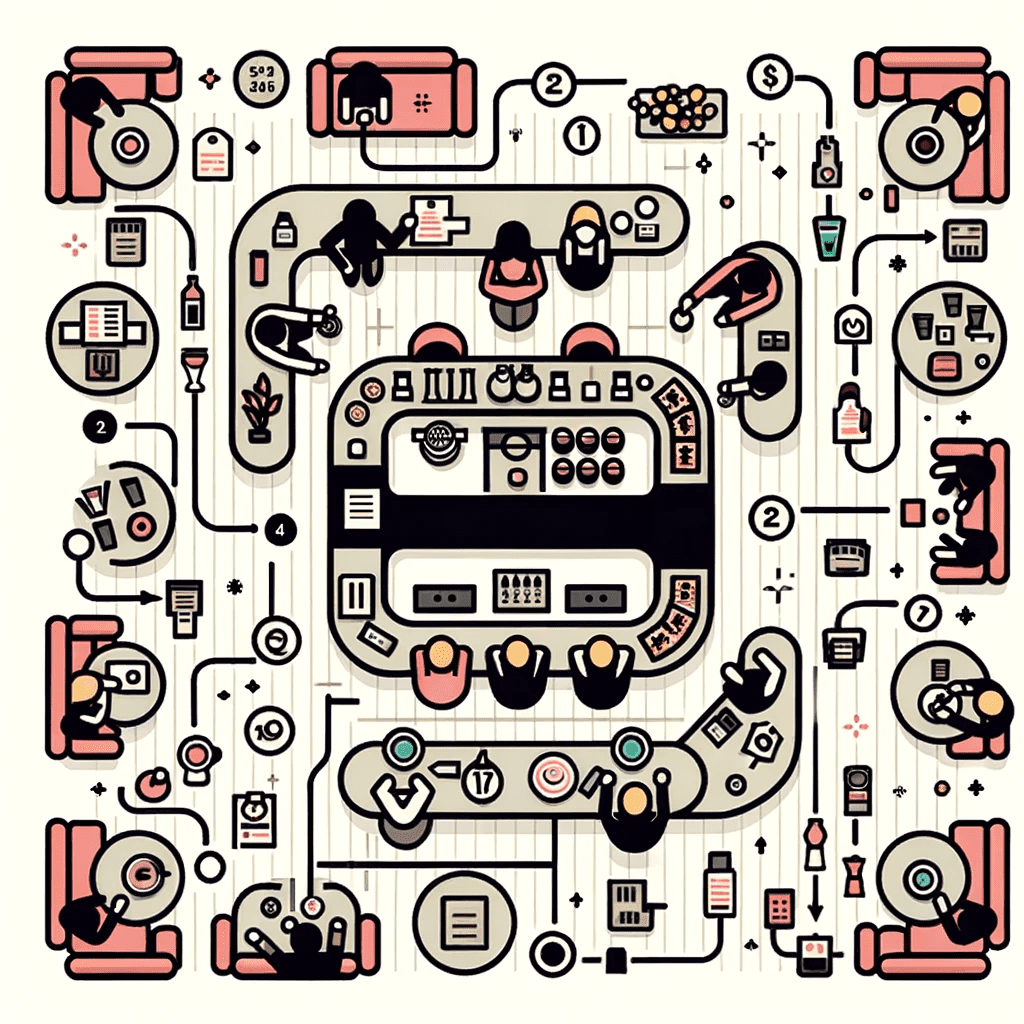Understanding customer behavior is of utmost importance in the bar industry. By analyzing customer behavior, bars can gain valuable insights that help them predict customer value, personalize experiences, and improve customer retention. In this article, we will explore the concept of customer behavior analysis and its relevance to bars. We will also delve into the key sections of this article to provide a comprehensive understanding of how bars can leverage customer behavior analysis to enhance their operations and drive success.
Customer Behavior Analysis for Bars
Customer behavior analysis for bars involves studying how customers engage with a bar and understanding their preferences, habits, and decision-making processes. It is a systematic approach that allows bar owners and managers to gain insights into customer behavior patterns and make data-driven decisions to optimize their operations. By breaking the audience into segments and analyzing their behavior, bars can tailor their offerings, marketing strategies, and customer experiences to meet specific customer needs and preferences.
For example, let's consider a bar that conducts customer behavior analysis and identifies two main customer segments: craft beer and cocktail enthusiasts. By understanding the preferences and behaviors of these two segments, the bar can curate a menu that offers a wide selection of craft beers and innovative cocktail options. This personalized approach attracts customers from these segments and enhances their overall experience, leading to increased customer satisfaction and loyalty.
To conduct customer behavior analysis effectively, bars can utilize various tools and technologies. Woopra, Hotjar, Brand24, Qualtrics CustomerXM, Determ, and social media analytics are some of the tools available that can assist in gathering and analyzing customer behavior data. These tools provide valuable insights into customer interactions, preferences, and sentiments, enabling bars to make informed decisions to optimize operations and improve customer experiences.

Key Insights from Customer Behavior Analysis
Customer behavior analysis in the bar industry has revealed several key insights that can guide bars' decision-making processes. Let's explore some of these insights:
Differences in Spending Habits
One interesting insight from customer behavior analysis is the difference in spending habits between males and females when dining at bars. Studies have shown that males spend more than females, which can be crucial when designing pricing strategies and promotions.
Generational Trends
Another important insight is the generational trends in bar visits. Customer behavior analysis has shown that millennials go to bars more frequently than older generations. This information can help bars tailor their offerings and marketing strategies to cater to the preferences and needs of different generations.
Importance of Brand Loyalty
Customer behavior analysis has emphasized the significance of brand loyalty in the success of bars. Focusing on regular customers and building strong relationships can increase customer retention and positive word-of-mouth recommendations.
Factors Influencing Bar Visits
Various factors influence customers' decisions to visit a bar. Customer behavior analysis has identified key factors such as the food and drink menu, price, technology offerings, and social media presence. Bars that pay attention to these factors and make data-driven decisions can attract and retain more customers.
Consumer Behavior Regarding Drink Orders
Understanding consumer behavior regarding drink orders is crucial for bars. Studies have revealed that many customers do not know their drink order when entering a bar. Additionally, many customers will likely order an additional drink if given the opportunity. Bars can leverage this information to provide recommendations and create upselling opportunities.
By analyzing these key insights and incorporating them into their operations, bars can enhance the overall customer experience and increase customer satisfaction.

Personalizing Customer Experiences in Bars
Personalization is a powerful strategy that can significantly impact customer satisfaction and loyalty. Customer behavior analysis allows bars to understand the preferences and behaviors of different customer segments and tailor their offerings accordingly. By collecting and analyzing data on customer preferences, bars can create personalized experiences that resonate with their target audience.
For instance, imagine a bar catering to sports enthusiasts and cocktail lovers. By utilizing customer behavior analysis, the bar can identify the specific preferences of these two segments. For sports enthusiasts, the bar can offer special promotions during major sporting events and create an ambiance that caters to their interests. On the other hand, for cocktail lovers, the bar can curate a unique menu of handcrafted cocktails and provide mixology classes or workshops. These personalized experiences attract customers and create a strong emotional connection, leading to increased customer satisfaction and loyalty.
Data-driven personalization strategies have proven to be successful in the bar industry. By leveraging customer behavior analysis, bars can gain a competitive edge by delivering tailored experiences that exceed customer expectations.
Optimizing the Customer Journey in Bars
The bar's customer journey encompasses various stages, including discovering the bar, making a reservation, ordering drinks, and providing feedback. Customer behavior analysis is vital in optimizing each journey stage by identifying pain points and opportunities for improvement.
For example, let's consider the stage of ordering drinks. By analyzing customer behavior data, bars can identify common pain points, such as long wait times at the bar or difficulties in navigating the drink menu. With this information, bars can implement solutions such as introducing a mobile ordering system or providing digital menus to enhance the ordering experience. By addressing customer pain points, bars can create a seamless and enjoyable customer journey, increasing customer satisfaction and loyalty.
Moreover, customer behavior analysis helps bars optimize the customer journey by understanding customer preferences and behaviors at each stage. By aligning their operations and offerings with customer expectations, bars can ensure a positive and memorable customer experience.
Increasing Customer Lifetime Value in Bars
Customer lifetime value (CLV) is a crucial metric that measures the revenue a bar can expect from a customer over their entire relationship. Customer behavior analysis significantly increases CLV for bars by providing insights into customer preferences, behaviors, and purchasing patterns.
By understanding their customers' preferences, bars can implement strategies to encourage repeat visits and increase customer spend. For example, a bar can leverage customer behavior insights to create personalized loyalty programs that offer rewards based on customer preferences. By offering incentives and rewards tailored to individual customers, bars can foster customer loyalty and increase the likelihood of repeat visits.
Upselling is another effective strategy that can be enhanced through customer behavior analysis. By analyzing customer behavior, bars can identify opportunities to upsell by recommending premium drinks or offering add-ons that align with customer preferences. This increases customer spend and enhances the overall customer experience, leading to increased customer satisfaction and loyalty.
Emerging Trends in Customer Behavior Analysis for Bars
The field of customer behavior analysis is constantly evolving, and bars need to stay updated with the latest trends. Let's explore some of the emerging trends in customer behavior analysis for bars:

Personalization
Personalization is becoming increasingly important in the bar industry. Customers expect a personalized experience that caters to their preferences and needs. Bars can leverage customer behavior analysis to segment their customer base and create personalized offerings, promotions, and recommendations. By delivering personalized experiences, bars can differentiate themselves and build stronger customer relationships.
Influence of Technology
Technology is transforming the way bars operate and interact with their customers. Digital menus, mobile ordering systems, and interactive touch screens are becoming more prevalent in bars. Customer behavior analysis can help bars understand how customers interact with these technologies and identify opportunities for improvement. By embracing technology and integrating it into the customer experience, bars can enhance customer satisfaction and streamline operations.
Impact of Social Media
Social media platforms play a significant role in shaping customer perceptions and decisions. Customers often turn to social media to research and discover new bars. By analyzing social media data and customer behavior, bars can gain insights into customer preferences, sentiment, and engagement. This information can be used to refine marketing strategies, engage with customers on social platforms, and build a strong online presence.
Staying updated with emerging trends in customer behavior analysis is essential for bars to remain competitive and meet evolving customer expectations.
Tools for Conducting Customer Behavior Analysis
Various tools and technologies are available to assist bars in conducting customer behavior analysis. Let's explore some of these tools:
Woopra
Woopra is a comprehensive customer analytics platform that provides real-time insights into customer behavior. It enables bars to track customer interactions, segment their customer base, and analyze data to gain actionable insights. With Woopra, bars can understand customer preferences, personalize experiences, and optimize operations to enhance customer satisfaction and loyalty.
Hotjar
Hotjar is a powerful tool that allows bars to understand customer behavior through heatmaps, session recordings, and surveys. It provides visual representations of customer interactions on the bar's website or app, helping bars identify areas of improvement and optimize their digital customer experience. By leveraging Hotjar, bars can make data-driven decisions to enhance their online presence and attract more customers.
Brand24
Brand24 is a social media monitoring and analytics tool that enables bars to track and analyze customer conversations and sentiments on social media platforms. By monitoring mentions, comments, and reviews, bars can gain valuable insights into customer perceptions and preferences. Brand24 also allows bars to engage with customers in real time, enabling them to respond promptly to feedback and build stronger relationships.
Qualtrics CustomerXM
Qualtrics CustomerXM is an experience management platform that helps bars collect and analyze customer feedback at every touchpoint. It enables bars to gather insights through surveys, feedback forms, and customer satisfaction metrics. By leveraging Qualtrics CustomerXM, bars can understand customer expectations, identify areas for improvement, and create data-driven strategies to enhance the overall customer experience.

Determ
Determ is a media monitoring and social listening software that enables bars to analyze customer sentiment, track brand mentions and monitor industry trends. It provides valuable insights into customer perceptions and preferences, allowing bars to make informed decisions and stay ahead of the competition. By leveraging Determ, bars can understand customer behavior patterns and adapt their strategies accordingly.
Customer behavior analysis tools like Woopra, Hotjar, Brand24, Qualtrics CustomerXM, and Determ are valuable assets for bars seeking to understand their customers and make data-driven decisions to enhance their operations and customer experiences.
Challenges and Ethical Considerations in Customer Behavior Analysis
While customer behavior analysis offers numerous benefits, there are challenges and ethical considerations that bars must address. Let's explore some of these challenges:
Data Collection and Bias
Collecting accurate and unbiased data can be challenging. Bars need to ensure that the data they collect is a true reflection of customer behavior and preferences. Additionally, biases in data collection and analysis can skew the results. Bars should be aware of potential biases and take steps to mitigate them, such as using representative samples and diverse data sources.
Data Privacy and Responsible Usage
Data privacy is a critical concern when conducting customer behavior analysis. Bars must prioritize data security and ensure that customer data is handled responsibly. Obtaining customer consent, following privacy regulations, and implementing robust data protection measures are essential for maintaining customer trust and complying with legal requirements.
Ethical Considerations
Ethical considerations arise when using customer data for analysis. Bars should use customer data responsibly and transparently, ensuring that customer privacy is respected and data is used solely for the intended purpose. Transparent customer communication about data collection and usage is essential to build trust and maintain a positive reputation.
By addressing these challenges and adhering to ethical practices, bars can conduct customer behavior analysis responsibly and effectively.
The Future of Customer Behavior Analysis in the Bar Industry
The future of customer behavior analysis in the bar industry holds immense potential. Let's explore some predictions and opportunities for the future:
Advancements in Technology
Advancements in technology, such as artificial intelligence and machine learning, will revolutionize customer behavior analysis. These technologies will enable bars to gain deeper insights into customer behavior, make more accurate predictions, and deliver highly personalized experiences. For example, AI-powered recommendation systems can suggest drinks based on customer preferences and past behavior, enhancing the overall customer experience.
Integration of Data Sources
Integrating data from various sources will provide a comprehensive understanding of customer behavior. By combining data from social media, online reviews, and in-house systems, bars can gain a holistic view of customer preferences and sentiments. This integrated data can refine marketing strategies, tailor offerings, and drive customer loyalty.
Emerging Technologies and Methodologies
Emerging technologies and methodologies, such as sentiment analysis, natural language processing, and predictive modeling, will be crucial in customer behavior analysis. These advancements will enable bars to analyze vast amounts of data, extract meaningful insights, and predict customer behavior more accurately. By embracing these technologies and methodologies, bars can stay ahead of the competition and deliver exceptional customer experiences.
The future of customer behavior analysis in the bar industry is undoubtedly exciting. By leveraging technological advancements, integrating data sources, and embracing emerging technologies and methodologies, bars can unlock new opportunities and drive business success.
Conclusion
Understanding customer behavior is paramount for bars thriving in a competitive industry. Customer behavior analysis provides valuable insights into customer preferences, habits, and motivations, enabling bars to predict customer value, personalize experiences, and improve customer retention. By leveraging tools and technologies, analyzing data effectively, and staying updated with emerging trends, bars can optimize their operations, enhance the customer journey, and increase customer lifetime value. Implementing data-driven strategies based on customer behavior insights is key to success in the bar industry. By continually analyzing customer behavior and adapting to evolving customer expectations, bars can create exceptional experiences that keep customers returning for more.